Zoom
Trash

Closed Wallets, Closed Minds - trend report from David Report. We are increasingly suffering from consumption fatigue, but brands and designers have yet to acknowledge the fact, reckons David Carlson in this issue of the David Report.
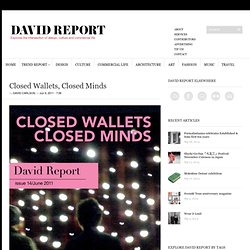
Brands must either get used to the idea of a world in which we buy less, which will at least test theories that endless economic growth is a social necessity, or they need to speak to consumers with new resonance. The Closed Wallets, Closed Minds trend report is originally written by David Carlson for Viewpoint #27. Flood Wall Street: Photos from the Front Lines. Monday, after the historic 400,000 People's Climate March (PCM) the day previous, over 4,000 students, professors, scientists, activists, journalists, and others marched on Wall Street to demand an end to capitalism.
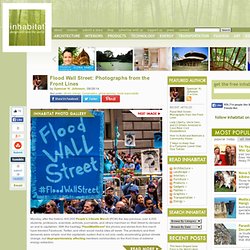
With the hashtag "FloodWallStreet" the photos and stories from this march have trended Facebook, Twitter, and other social media sites all week. The protestors and their demands were simple: end the capitalistic system that is not only vastly accelerating global climate change, but disproportionately affecting members communities on the front lines of extreme energy extraction. Before the Flood, speakers included impacted front line residents like youth activist Ta’Kaiya Blaney who explained that recently in her community oil sludge trailing ponds spilled into two of the world’s biggest salmon runs.
Following the People’s Climate March, #FloodWallStreet was one of the first steps of humanity taking bold action on climate change. All photos by Spencer H. About Me. I'm Chris Anderson, editor-in-chief of Wired Magazine.
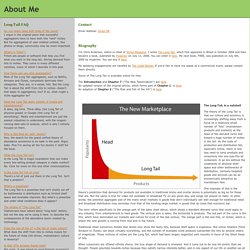
I wrote The Long Tail, which first appeared in Wired in October 2004 and then became a book, published by Hyperion on July 11, 2006. You can order it here. My next book, FREE, was published on July 6th, 2009 by Hyperion. You can buy it here. My speaking engagements are handled by The Leigh Bureau If you'd like to have me speak at a commercial event, please contact them directly. Still figuring it out: Tavi Gevinson at TEDxTeen. 10 Global Macro Trends for the Next Five Years. Despite the uncertainties facing the global economy, certain trends are inevitable.
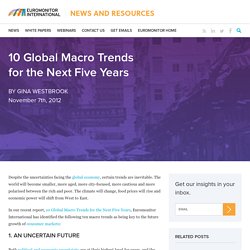
The world will become smaller, more aged, more city-focused, more cautious and more polarised between the rich and poor. The climate will change, food prices will rise and economic power will shift from West to East. In our recent report, 10 Global Macro Trends for the Next Five Years, Euromonitor International has identified the following ten macro trends as being key to the future growth of consumer markets: 1. An uncertain future Both political and economic uncertainty are at their highest level for years, and the situation is expected to continue with flow on effects for consumers who in view of uncertain times may well exercise caution when making purchasing decisions. 2. 3. 4.
Inequality has been in evidence for a number of years, but is increasingly becoming a focus of social unrest and media interest. 5. 6. A combination of low birth rates and longer life expectancies is driving the ageing process. The Power of Proximity – the Complex Story of 21st Century Cities. For the first time ever, over half of the global population lives in cities, a number expected to reach 60-80% by 2050.

While much of the urbanisation of the previous two decades has been in the Asia Pacific region, the next wave of urbanisation is expected to be in Africa and the Middle East. Euromonitor International's latest report, The Power of Proximity – the Complex Story of 21st Century Cities, examines the rise of megacities (with over 10 million inhabitants), and characterises mature, rising and emerging cities.
Also considered are the relationships between cities and digital technology and culture, as well those between cities and inequality and political instability. This report highlights the following issues: Whereas cities have been regarded as the powerhouses of the global economy, now they are the global economy. Note: A megacity is a metropolitan area (urban agglomeration) with a total population in excess of 10 million people. LowLine: An Underground Park on NYC's Lower East Side by Dan Barasch.
What is the LowLine?
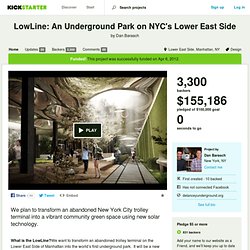
We want to transform an abandoned trolley terminal on the Lower East Side of Manhattan into the world’s first underground park. It will be a new kind of public space, using solar technology for natural illumination, and cutting edge design to capture and highlight a very special industrial space. A park… underground?!? Ever wonder why there's so little green space in New York? There aren’t a lot of empty plots of land just waiting to be turned into new parks. A few years ago, we learned about a massive unused former trolley terminal in our neighborhood, the Lower East Side.
What is the space like? Here's what's even more exciting: it's in the heart of the Lower East Side. Let the Sun Shine... What kind of a park is underground? We think a year-round public space will be valuable for everyone. When it's really cold, or pouring rain, how much fun is it to hang out in Central Park? We hope you’ll support our effort to build a new kind of park. Garden Bridge. AboutThe GardenBridge London’s Garden Bridge will be a stunning new public garden and pedestrian crossing, spanning the River Thames, linking the South Bank to Temple station and beyond.

Designed by Heatherwick Studio and inspired by actress and campaigner, Joanna Lumley, the Bridge will provide a vital new route between north and south London and feature plants, trees, woodland and meandering walkways to be used and enjoyed by all.